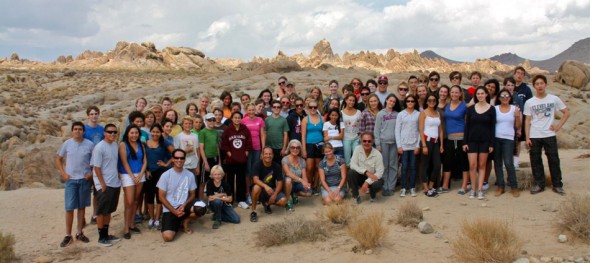Beginning-of-the-Year Trip: The Eastern Sierra
Chaperones: Gordon and Suzie Sichi, Bryan Anderson, Hugo Macario, Megan Nesland, John Luca, and Connor Proctor (Class of 2011).
The Senior Class and Faculty organized the menus and helped purchase the food. Everyone is to be commended for working in teams to prepare, cook, and clean up for all of the breakfasts, lunches and dinners. Every student participated, including preparation and cleanup. A job well done!
Monday, September 10, 2012, Trip Preparation Day
Students spent all day preparing for the trip. Gordon Sichi began the day by going over the itinerary and equipment list. He also showed the students pictures taken on a recent trip of the Bristlecone Pines and the radio astronomy facility maintained by CARMA. Frank Davis of UCSB’s Bren School gave the students an excellent power point lecture about tree rings in general and the unique role Bristlecones play in climate science. Anacapa science teacher, Megan Nesland, offered the students a highly innovative lesson on the geology of the Sierra by using her original epic poem with students interacting and interpreting the geological history of the Sierra . Gordon Sichi concluded the morning with a brief history of the Los Angeles Aqueduct and its impact on the Owens River Valley. In the afternoon Megan gave a creative power point talk about packing the right clothes for the trip, then Food Group Teams met to go over the details of their duties.
Tuesday, September 11, Lone Pine Film Museum, Mount Whitney Fish Hatchery, and Talk by Paiute/Shoshone Native Americans
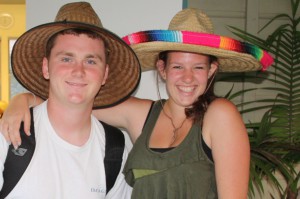 Students arrived at 6:30 AM for a 7:00 AM departure from Campus. The loading of the bus and vans went very smoothly, and we departed on time with the bus full of 7th-10th graders. Bryan and Megan drove Senior and juniors separately; each had their own van for some class bonding. Our first stop was the town of Lone Pine for a tour of the Museum of Lone Pine Film Museum. After an introduction to the history of film in the Lone Pine area by film historian and executive director of the museum, Chris Langley, students saw a special film on the prominent role Lone Pine has played and continues to play in the film industry. A lively Q and A session with Chris Langley followed the film. Students toured the museum, and then we took off for the nearby Alabama Hills, site of so much of the local filming. After a short walk to a scenic location, we took off for the Mount Whitney Fish Hatchery. Volunteer, Bruce Ivy, met us and gave us a detailed tour, which covered the building of the historic 1915 landmark stone building, the recent challenges from the 2007 fire that caused flooding in 2008, which closed the hatchery, and the recent resurrection of the hatchery, thanks to volunteer efforts. Inside the hatchery, students learned about the biological processes of raising trout from sperm and eggs harvested from mature fish in the nearby pond. After seeing a film about the history of the Hatchery, we met outside and finished our tour by feeding the huge Rainbow Trout in the pond. Then, it was off to the Bernasconi Education Center, where Anacapa had exclusive use of this facility, which included dormitories for the students, a house for the teachers, a fully equipped kitchen and dining hall, and meeting rooms for educational activities. The Bernasconi Center is operated by Inyo County Schools and is open to outside groups. Situated with 360-degree views of the White Mountains, Owens Valley, and the Sierra Crest, it is a stunning location. Before dinner, students enjoyed playing volleyball, basketball, soccer, horseshoes, and gymnastics at the well equipped facility. After a dinner of Chicken Caesar salad, two local Native Americans met students in the Amphitheater. Paiute Gina Jones and Shoshone Joanie Hanson, shared the history of their tribes and families in the Owens Valley (Paiute Tribe) and Death Valley (Shoshone Tribe) areas of Inyo County. Students had lots of good questions, and our presenters were very informative and thoughtful with their answers and stories.
Students arrived at 6:30 AM for a 7:00 AM departure from Campus. The loading of the bus and vans went very smoothly, and we departed on time with the bus full of 7th-10th graders. Bryan and Megan drove Senior and juniors separately; each had their own van for some class bonding. Our first stop was the town of Lone Pine for a tour of the Museum of Lone Pine Film Museum. After an introduction to the history of film in the Lone Pine area by film historian and executive director of the museum, Chris Langley, students saw a special film on the prominent role Lone Pine has played and continues to play in the film industry. A lively Q and A session with Chris Langley followed the film. Students toured the museum, and then we took off for the nearby Alabama Hills, site of so much of the local filming. After a short walk to a scenic location, we took off for the Mount Whitney Fish Hatchery. Volunteer, Bruce Ivy, met us and gave us a detailed tour, which covered the building of the historic 1915 landmark stone building, the recent challenges from the 2007 fire that caused flooding in 2008, which closed the hatchery, and the recent resurrection of the hatchery, thanks to volunteer efforts. Inside the hatchery, students learned about the biological processes of raising trout from sperm and eggs harvested from mature fish in the nearby pond. After seeing a film about the history of the Hatchery, we met outside and finished our tour by feeding the huge Rainbow Trout in the pond. Then, it was off to the Bernasconi Education Center, where Anacapa had exclusive use of this facility, which included dormitories for the students, a house for the teachers, a fully equipped kitchen and dining hall, and meeting rooms for educational activities. The Bernasconi Center is operated by Inyo County Schools and is open to outside groups. Situated with 360-degree views of the White Mountains, Owens Valley, and the Sierra Crest, it is a stunning location. Before dinner, students enjoyed playing volleyball, basketball, soccer, horseshoes, and gymnastics at the well equipped facility. After a dinner of Chicken Caesar salad, two local Native Americans met students in the Amphitheater. Paiute Gina Jones and Shoshone Joanie Hanson, shared the history of their tribes and families in the Owens Valley (Paiute Tribe) and Death Valley (Shoshone Tribe) areas of Inyo County. Students had lots of good questions, and our presenters were very informative and thoughtful with their answers and stories.
Wednesday, September 12, Bristlecone Pine Forest, CARMA and Star Party
The prime objective of this Beginning of the Year Trip for Headmaster Gordon Sichi was to realize a long-term dream of having Anacapa students visit the oldest living forest in the world—The Ancient Bristlecones of the White Mountains. This required special transportation arrangements for the narrow and windy road to the Bristlecones.  Bishop Unified School District generously offered to charter the right type of bus with an experienced driver named Lisa to safely transport our school to the high elevation forest. We arrived by 9:00 and broke up into individual class groups that started off separately, so the trail wouldn’t be too crowded. Students took the 4.5 mile Methuselah Walk, stopping at each of the 23 markers, which with the trail guide of excellent information provided by the Forest Service, explain the story of the Bristlecones. Between marker 16 and 17, the oldest life on earth exists among beautifully sculpted tress in a steep canyon with some living trees being over 4,500 years old and with deadwood on the ground , cross-dated back to 11,000 years! After the walk back into time before the existence of ancient civilizations, we drove 30 minutes to CARMA, the largest radio astronomy site in the world, CARMA, The Combined Array for Research in Millimeter Wave Astronomy, sits on top of the White Mountains at a perfect location to explore the cosmos. Anacapa was privileged to have a private tour of this cutting edge research facility, which is jointly operated by Caltech, the University of California, Berkeley, the University of Illinois, the University of Maryland and the University of Chicago. Each university has an array of different sized radio telescopes that total 23 telescopes of varying sizes and that collectively make up the largest array of radio telescopes in the world. Thanks to Caltech’s Nikolaus Volgeneau, students were grouped in three different groups and given a detailed tour of the research facility. Because it was a maintenance day, students were allowed to climb up into some of the telescopes. After going from the oldest forest in the world to the most advanced research facility for observing the universe, we returned to the Bernasconi Center for a dinner of good old hamburgers and hot dogs, French fries and watermelon. Yum! Compliments to the chefs! After dinner, local astronomer extraordinaire, Mark Hodges of CARMA, set up his telescope and gave a talk on the constellations, which was followed by looks into his telescope to see distant stars and galaxies. What an extraordinary day!
Bishop Unified School District generously offered to charter the right type of bus with an experienced driver named Lisa to safely transport our school to the high elevation forest. We arrived by 9:00 and broke up into individual class groups that started off separately, so the trail wouldn’t be too crowded. Students took the 4.5 mile Methuselah Walk, stopping at each of the 23 markers, which with the trail guide of excellent information provided by the Forest Service, explain the story of the Bristlecones. Between marker 16 and 17, the oldest life on earth exists among beautifully sculpted tress in a steep canyon with some living trees being over 4,500 years old and with deadwood on the ground , cross-dated back to 11,000 years! After the walk back into time before the existence of ancient civilizations, we drove 30 minutes to CARMA, the largest radio astronomy site in the world, CARMA, The Combined Array for Research in Millimeter Wave Astronomy, sits on top of the White Mountains at a perfect location to explore the cosmos. Anacapa was privileged to have a private tour of this cutting edge research facility, which is jointly operated by Caltech, the University of California, Berkeley, the University of Illinois, the University of Maryland and the University of Chicago. Each university has an array of different sized radio telescopes that total 23 telescopes of varying sizes and that collectively make up the largest array of radio telescopes in the world. Thanks to Caltech’s Nikolaus Volgeneau, students were grouped in three different groups and given a detailed tour of the research facility. Because it was a maintenance day, students were allowed to climb up into some of the telescopes. After going from the oldest forest in the world to the most advanced research facility for observing the universe, we returned to the Bernasconi Center for a dinner of good old hamburgers and hot dogs, French fries and watermelon. Yum! Compliments to the chefs! After dinner, local astronomer extraordinaire, Mark Hodges of CARMA, set up his telescope and gave a talk on the constellations, which was followed by looks into his telescope to see distant stars and galaxies. What an extraordinary day!
Thursday, September 13, All-School Hike to Big Pine Lakes
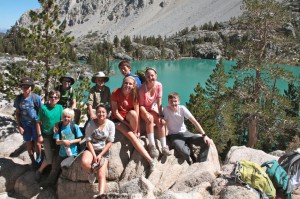 We assembled at the 7,800’ trailhead for Big Pine Lakes at 9:00 AM and broke up into 5 groups based on how fast each group wanted to go. Bryan Anderson stayed back with the 6 students, who for varying reasons, were unable to make the 9 mile hike with over 2000’ of elevation up and 2000’ feet down back to the trailhead. Hugo Macario took Group 1, Connor Proctor and John Luca took Group 2, Gordon Sichi took Group 3, Suzie Sichi took Group 4, and Megan Nesland took Group 5. Teachers were all linked by radios, so if a student needed to change groups, then communications were made and the changes were easily made. After climbing up the steep slope from which pours gushing Second Fall, all groups met up at the 2.9-mile mark of Lon Chaney’s stone cabin along Big Pine Creek. Water was pumped with water filters from the creek to refresh the water bottles and students snacked before resuming the remaining 1.5 miles of steep climbing to First Lake, and then the short traverse to Second Lake. Groups 1-4 arrived at approximately 2:00 PM to Second Lake, which is turquoise colored, because of the run-off from the glaciers high above the lakes. The nearby Palisades Glaciers are the largest remaining glaciers in the Sierra. Jutting high above Second Lake is the awesome Temple Crag Mountain, which is one of the most famous climbing mountains in the Sierra. Last but not least, Group 5 was determined to make it all the way to Second Lake, and with all of their positive energy they arrived at 3:30. Everyone cheered the hikers and greeted them for a short rendezvous before heading back down the trail. Gordon Sichi took his traditional spot on all-school hikes of taking the last group back to the trailhead. The energy in Group 5 was very positive and supportive of each other. Time was a little tight for Anacapa, as we had reservations for dinner at Rossi’s between 5:00 and 6:00. Suzie Sichi took a van directly to Rossi’s to warn them we were going to be late. Rossi’s closed their restaurant to the public just for Anacapa, and we filled every seat in their historic dining room. Salad, rolls, spaghetti and ravioli and pistachio ice cream filled our hungry hikers to the brim. Local pianist Elijah Muldoon played classics for us and Anacapa keyboardist Sam Robertson joined him for a duet and played some songs himself. Back at Bernasconi the students enjoyed free time after dinner playing volleyball and other spontaneous games.
We assembled at the 7,800’ trailhead for Big Pine Lakes at 9:00 AM and broke up into 5 groups based on how fast each group wanted to go. Bryan Anderson stayed back with the 6 students, who for varying reasons, were unable to make the 9 mile hike with over 2000’ of elevation up and 2000’ feet down back to the trailhead. Hugo Macario took Group 1, Connor Proctor and John Luca took Group 2, Gordon Sichi took Group 3, Suzie Sichi took Group 4, and Megan Nesland took Group 5. Teachers were all linked by radios, so if a student needed to change groups, then communications were made and the changes were easily made. After climbing up the steep slope from which pours gushing Second Fall, all groups met up at the 2.9-mile mark of Lon Chaney’s stone cabin along Big Pine Creek. Water was pumped with water filters from the creek to refresh the water bottles and students snacked before resuming the remaining 1.5 miles of steep climbing to First Lake, and then the short traverse to Second Lake. Groups 1-4 arrived at approximately 2:00 PM to Second Lake, which is turquoise colored, because of the run-off from the glaciers high above the lakes. The nearby Palisades Glaciers are the largest remaining glaciers in the Sierra. Jutting high above Second Lake is the awesome Temple Crag Mountain, which is one of the most famous climbing mountains in the Sierra. Last but not least, Group 5 was determined to make it all the way to Second Lake, and with all of their positive energy they arrived at 3:30. Everyone cheered the hikers and greeted them for a short rendezvous before heading back down the trail. Gordon Sichi took his traditional spot on all-school hikes of taking the last group back to the trailhead. The energy in Group 5 was very positive and supportive of each other. Time was a little tight for Anacapa, as we had reservations for dinner at Rossi’s between 5:00 and 6:00. Suzie Sichi took a van directly to Rossi’s to warn them we were going to be late. Rossi’s closed their restaurant to the public just for Anacapa, and we filled every seat in their historic dining room. Salad, rolls, spaghetti and ravioli and pistachio ice cream filled our hungry hikers to the brim. Local pianist Elijah Muldoon played classics for us and Anacapa keyboardist Sam Robertson joined him for a duet and played some songs himself. Back at Bernasconi the students enjoyed free time after dinner playing volleyball and other spontaneous games.
Friday, September 14, Road Trip to Mono lake and June lake and special lecture by Cosmologist John Carlstrom
After breakfast and packing our lunches, we took off at 8:30 for our guided tour of Mono Lake led by Bartsche Miller of the Mono Lake Committee. Bartsche is a famous figure in the effort to preserve Mono Lake and educate visitors to the ecology of Mono Lake. A reoccurring theme of Anacapa’s trip to the Eastern Sierra was exposing the students to the historic diversion of Sierra streams in the Eastern Sierra by William Mulholland to deliver water to the Los Angeles Aqueduct. Mono Lake provides a perfect case study of the negative impacts of such diversion to the environment. Streams diverted to LA caused a big drop in the water levels of Mono Lake, which was hurting hurt wildlife, especially birds. Bartsche explained how a historic lawsuit victory against the LA Department of Water and Power, based on the defense of the “public trust” (a legal principle from ancient Roman Law), has helped restore Mono Lake to a now sustainable level. Bartsche showed us where the level of the future Mono Lake will rise, and then he took us on a tour of the lake with its unique wildlife, including brine shrimp and flies that thrive on the super saline/alkaline water of Mono Lake. He demonstrated by a lab demo how calcium from fresh water springs combined with carbonate from the saline waters makes the reaction that produces Mono Lake’s tufa towers. After hearing how easily swimmers float in the unique Mono Lake waters, many adventurous Anacapa students took a swim to find out for themselves. Bartsche also tied together the role Mono lake plays in the ecology of its flocks of birds, including the California Gull and migratory birds such as the Eared Grebes and Wilson’s Phalaropes that use Mono lake for fuel on their migrations to South America, which they do in a matter of 3 days! After leaving Mono Lake, we traveled about 30 minutes to beautiful June Lake for lunch and hanging out on the glacial moraine beach surrounded by stunning views. After lunch, we hustled back to the Berlasconi Center for a lecture by Cosmologist, John Carlstrom of the University of Chicago. This fortuitous opportunity was arranged by Nikolaus Volgeneau of CARMA, who accompanied John Carlstrom to provide technical support for his lecture into the deepest realms of the universe. He shared that there are 100 billion stars in the Milky Way (and his video of the Milky Way took us deep into it) and 100 billion galaxies in the Universe. The questions from the students, including new 7th graders, were excellent. 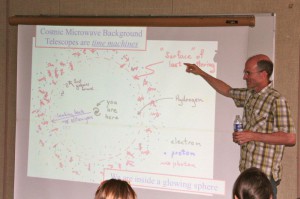 One 7th grader asked John Carlstrom, “Are there other universes?” He said he didn’t know. John clarified key concepts, such as that space is continually expanding at the same rate, but we don’t know what it is expanding into, or through, or its center. He concluded his mind bending lecture with a detailed photo lecture of the work that is being done by National Science Foundation to install a gigantic 10 meter radio telescope at the South Pole, and he explained why it was an ideal location to make observations deep into the universe. Our last dinner was a Mexican gourmet feast cooked up perfectly by head chefs Bryan and Hugo and their hard working crew. After the dishes were done, we met at the Amphitheater for songs and fun activities, and finished the evening off with the traditional “Anacapa Appreciations” in which each student and teacher gets to share something that she or he appreciated about the trip. The Seniors chose a great “talking stick” with a can purchased at the Bristlecone Visitor Center containing a seed to start a Bristlecone Pine tree.
One 7th grader asked John Carlstrom, “Are there other universes?” He said he didn’t know. John clarified key concepts, such as that space is continually expanding at the same rate, but we don’t know what it is expanding into, or through, or its center. He concluded his mind bending lecture with a detailed photo lecture of the work that is being done by National Science Foundation to install a gigantic 10 meter radio telescope at the South Pole, and he explained why it was an ideal location to make observations deep into the universe. Our last dinner was a Mexican gourmet feast cooked up perfectly by head chefs Bryan and Hugo and their hard working crew. After the dishes were done, we met at the Amphitheater for songs and fun activities, and finished the evening off with the traditional “Anacapa Appreciations” in which each student and teacher gets to share something that she or he appreciated about the trip. The Seniors chose a great “talking stick” with a can purchased at the Bristlecone Visitor Center containing a seed to start a Bristlecone Pine tree.
Saturday, September 15, Back to Santa Barbara with a stop at The Eastern California Museum in Independence, California.
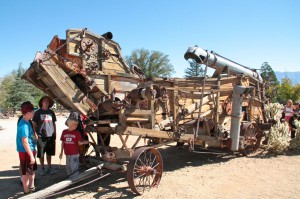 Our last educational stop of the 5-day trip was a tour of the Eastern California Museum in tiny Independence. Curator Roberta Harlan gave us a good overview of the museum and led students through the collections. This museum has outstanding collections on the history of Inyo County, including one of the largest collections of Owens Valley Paiute and Shoshone basketry in the world, photographs of the early history of the Owens Valley, and the Story of Manzanar, the Japanese American World War II Internment Center. Outside of the Museum, there is a special exhibition of native plants and an extensive collection of farm and mining implements from the past. Our safe return to Santa Barbara got us back at 4:40, twenty minutes early!
Our last educational stop of the 5-day trip was a tour of the Eastern California Museum in tiny Independence. Curator Roberta Harlan gave us a good overview of the museum and led students through the collections. This museum has outstanding collections on the history of Inyo County, including one of the largest collections of Owens Valley Paiute and Shoshone basketry in the world, photographs of the early history of the Owens Valley, and the Story of Manzanar, the Japanese American World War II Internment Center. Outside of the Museum, there is a special exhibition of native plants and an extensive collection of farm and mining implements from the past. Our safe return to Santa Barbara got us back at 4:40, twenty minutes early!

